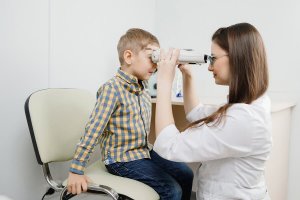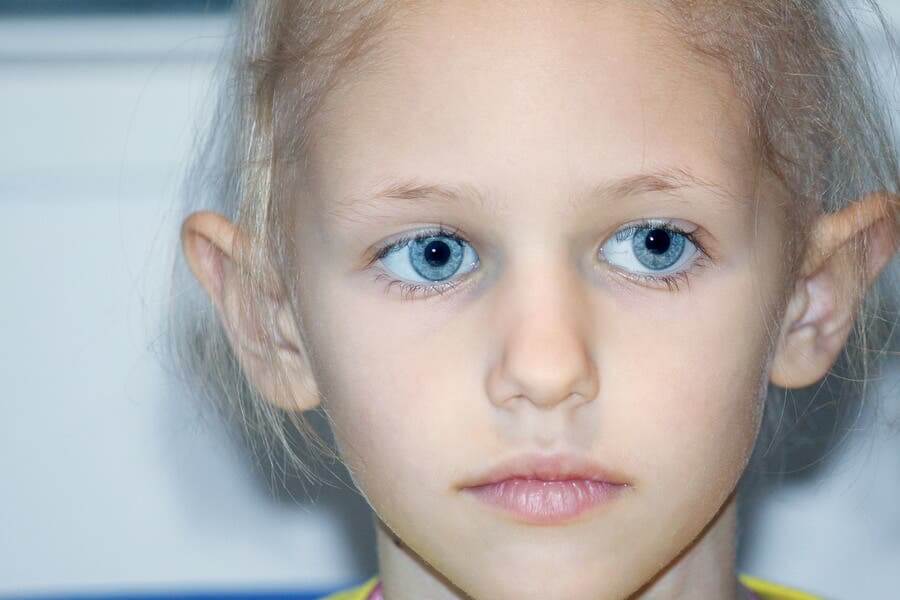Retinoblastoma: Symptoms, Causes and Treatment


Written and verified by the doctor Jael Garrido Dominguez
Retinoblastoma is a disease that affects the eye, and it usually happens at an early age. In fact, it’s the most common eye cancer during childhood.
Currently, it represents 3% of all childhood cancers, with an incidence of 1 case per 15,000-18,000 births. These figures mean there are about 5,000 new cases worldwide every year.
On average, the diagnosis happens around 18 months old. In addition, 90% of cases are discovered in the first 5 years of life, and it affects boys and girls equally.
Although its origin is well-known, the survival rate is between 86%-92% worldwide, and 70% in developing countries. What are the symptoms? What treatments are available? We’ll tell you more below.
Causes of retinoblastoma
Retinoblastoma is an oncological disease associated with the mutation of a gene. In fact, it’s called the retinoblastoma gene. When we talk about this gene, we’re talking about the mutation of chromosome 13.
For example, one function of chromosome 13 is the suppression of complex mechanisms of the retina cellular system, through the RB1 gene. However, if both loci of the gene in chromosome 13 are affected, it causes retinoblastoma.
There’s a family history of the disease in less than 10% of retinoblastoma cases. However, about 30%-40% of the cases are hereditary.

Symptoms
Leukocoria is the most common symptom, and it’s usually the first to appear. Leukocoria is the appearance of a white reflex to the illumination of the retina. This is caused by a tumor that blocks the red reflex of the retina.
Other signs of retinoblastoma are:
- Squinting
- Impaired vision
- Red eyes
- Eye pain
- Ocular proptosis
You might like: Everything You Need to Know About a Detached Retina
Diagnosis
Although eye doctors usually diagnose this condition, there are other tests as well. For example, some of these are:
- DNA analysis. Usually, these tests find and document hereditary variables of this disease, both in the family and the child.
- Eye sonogram
- Tomography
- MRI
Each of these tests is to help health professionals tell the difference between this problem and pseudoretinoblastomas. In fact, these are a group of tumors that simulate the symptoms and characteristics of retinoblastoma, and people often confuse them.
Retinoblastoma treatment
Treatment against retinoblastoma is aimed at achieving three main purposes:
- Saving the life of the child that suffers from it
- Protecting the affected eyeball
- Achieving optimal vision
In most cases, the treatment is individualized to each patient. Also, they take into account the complexity of the situation. The most common treatments for retinoblastoma are:
External beam radiation therapy
In this type of treatment, doctors usually control the tumor locally, and it doesn’t usually leave lasting effects on the retina. However, mortality cases with this treatment are significantly high. Also, it may stop the face bones from growing.

Radioactive isotope plates
During this treatment, the doctor puts radioactive plates on the eye. This type of treatment helps minimize exposure of healthy tissue to radiation. However, they can only use this in some specific part of the tumor.
Chemotherapy
This treatment is generally reserved for the most complicated and advanced cases of retinoblastoma. Also, doctors can use it with beam radiation therapy to make the tumor smaller.
Also read: Preventing Sickness and Nausea Associated with Chemotherapy
Final thoughts on retinoblastoma
Retinoblastoma is an oncological disease that mainly affects children under 5 years old. A genetic mutation causes it, which happens in about 30% of cases. The most common symptom is leukocoria, which is where you see a white reflection when exposed to light.
Finally, there are different treatments, each with its own advantages and disadvantages. All of them help preserve life, the eye, and the patient’s vision.
All cited sources were thoroughly reviewed by our team to ensure their quality, reliability, currency, and validity. The bibliography of this article was considered reliable and of academic or scientific accuracy.
- Retinoblastoma: Background, Pathophysiology, Epidemiology. (2020). https://emedicine.medscape.com/article/1222849-overview#a5
- Dimaras, H., Kimani, K., Dimba, E. A., Gronsdahl, P., White, A., Chan, H. S., & Gallie, B. L. (2012). Retinoblastoma. The Lancet, 379(9824), 1436-1446. https://doi.org/10.1016/S0140-6736(11)61137-9
- Rao, R., & Honavar, S. G. (2017). Retinoblastoma. The Indian Journal of Pediatrics, 84(12), 937–944. doi:10.1007/s12098-017-2395-0
This text is provided for informational purposes only and does not replace consultation with a professional. If in doubt, consult your specialist.








